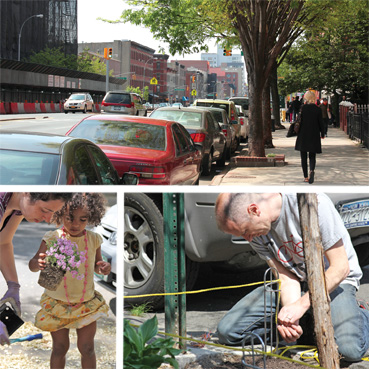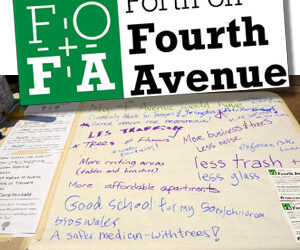At the turn of the last century, Fourth Avenue was a large, tree-lined boulevard. Since then, it’s seen many big changes. After the Fourth Avenue subway line was built in 1915, the street’s character became more industrial; eventually it transformed into a multilane urban thoroughfare with many chain stores and auto-repair shops. The next development was, literally, more development — the construction of new and often-nondescript buildings, after local rezoning in 2003 and 2005 allowed for greater building heights.

Over the past two years, there has been another round of action related to planning, which should bring yet another change — this time for a greener, more diverse, more accessible Fourth Avenue. And the Park Slope Civic Council has been at the forefront of those activities.
In 2010, the Civic Council worked to bring neighbors, businesses, and other stakeholders together to plan for the avenue’s future (a successful public forum that March, followed by an informative walking tour eight months later). Today, we have the Forth on Fourth Avenue Committee (FOFA), whose membership reflects the goal of preserving, promoting, and improving the Fourth Avenue community from Flatbush Avenue to the Prospect Expressway. The roster includes residents who’ve been here for decades and new arrivals, home and building owners, tenants, representatives of local civic organization, gardeners, and government officials.
A broad spectrum of concerns connect people to FOFA — pedestrian and bicycle safety, traffic calming, street greening and gardening, support for affordable housing, preservation of key local institutions that have helped define the neighborhood, and recycling.
The Civic Council is not the only one to realize that a transformation of Fourth Avenue is on its way. In 2011, Borough President Marty Markowitz established the Fourth Avenue Task Force, a community-based coalition of stakeholders along the boulevard’s entire length (from Flatbush to Shore Road in Bay Ridge). FOFA is well-represented in the task force’s committees (Medians and Beautification, chaired by Civic Council President Michael Cairl; Transportation and Safety; and Times Plaza). Our involvement helps us to see the “big picture,” provides an opportunity for discussions with public officials involved in planning, lets us exchange ideas with activists from other neighborhoods, and sometimes helps us anticipate issues for future community forums sponsored by the task force in our neighborhood.
The idea of a coalition of communities has helped FOFA flourish. In the past, plans for Fourth Avenue were shaped by the perception that the thoroughfare was only a boundary for Park Slope, which limited community involvement. Instead, we have found greater organizing success in emphasizing that Fourth Avenue is a shared space among local neighborhoods and intersecting streets. Residents and businesses in Park Slope, Boerum Hill, and Gowanus all hold a vested interest in making the avenue more livable.
The potential success of this strategy emerged with a program proposal developed by Grace Freedman, president of the Saint Marks Place Block Association. The project, covering Fourth Avenue from Bergen to Degraw Streets, focused on bringing together local organizations and merchants in a six-block greening effort that would include tree care and installation of window boxes. FOFA members reached out to block associations and organizations on both sides of Fourth, and were able to create a broader base of support. The Fourth Avenue Task Force’s Medians and Beautification Committee subsequently endorsed this so-called “pilot project.”
Spin-offs from the pilot project have been numerous:
‘Good Neighbor’ identification. FOFA is developing an awards program for businesses, organizations, and residential buildings that help with greening efforts on Fourth Avenue. Decals will showcase a participant’s efforts in improving the neighborhood.

Support to expand tree maintenance. Several FOFA members have already taken street-tree stewardship courses. As our first community-based project, FOFA surveyed current tree placement along Fourth (between Bergen and President Streets), then submitted a proposal for funding tree-bed support to the MillionTreesNYC Stewardship Corps. A brochure now in development will explain what residents and businesses would gain from taking care of their trees — economically, aesthetically, and environmentally. In addition, FOFA hopes to provide tree guards (a sturdy, inexpensive design is now being researched) at locations where someone is willing to assume maintenance, and help a first cultivation effort with plantings, mulch, and other resources. (You can learn how to adopt a street tree at www.milliontreesnyc.org.)
Civic Sweep on Fourth Avenue. The Civic Council’s Spring Civic Sweep in April was a perfect opportunity to test the impact of working on tree beds as an organizing tool, and FOFA decided to clean, cultivate, and plant at President Street, Butler Place, and St. Marks Place during the Sweep.
Community partnerships. Thanks to the pilot project, the MillionTreesNYC proposal, and the Civic Sweep, FOFA created partnerships that included the Saint Marks Place Block Association, the Butler/Baltic Block Association, the Fifth Avenue Committee (which maintains a number of residential buildings on or near Fourth Avenue), the Warren-St. Marks Community Garden, Bears Community Garden, the Boerum Hill Association, Slippery Slope Farm, the Gowanus Conservancy (through Film Biz Recycling), and Build It Green. GreenBridge, at the Brooklyn Botanic Garden, and the Green-Wood Historic Fund became resources for tree-care advice (and the latter for free wood-chip mulch). We are also exploring a collaboration to build planters with Brooklyn Woods, which helps unemployed and low-income New Yorkers start careers in skilled woodworking.
DIY tree guards. Rather than wait a while for requested tree guards from the Parks Department to become available, committee members have taken the initiative, experimenting with do-it-yourself approaches for such guards. A visible, workable design will show passersby that formerly garbage-strewn tree pits were being transformed into cared-for tree beds. One FOFA member tried out a simplified wood and rope approach; subsequently, Build It Green donated salvaged metal railings, which were used in a second round of DIY designs.
Local artist support. In March, FOFA supported a workshop that explored how local artists might contribute to the pilot project. Minuette Le, a graduate student at Parsons-The New School for Design, organized and led the workshop. With more than 25 attendees, the gathering was successful in engaging new people to talk about Fourth Avenue improvements. Also, three new people from the meeting joined FOFA.
The committee has also backed local groups in their site-specific improvement efforts. For example, the old KFC site on Fourth and Warren Street (soon to be a McDonald’s) has been a growing eyesore. Due to pressure from local residents (especially on St. Marks Place), violations have been issued for the site. Representatives from the Saint Mark’s Block Association had a preliminary discussion about the site at Borough Hall in February; the Borough President’s office is now going to set up a meeting with McDonald’s management and community groups, including FOFA and Park Slope Neighbors. The biggest concerns are that a drive-through entrance on Fourth is not reinstituted and that the site is properly maintained.
Clearly, many of FOFA’s initial efforts have centered on tree-related greening. Well-kept, clean tree beds are a sign that residents and businesses care for their community and want to see it thrive. To build on our accomplishments, the committee is also considering other projects beyond just tree care, such as identifying possible locations for traffic-calming efforts (bulb-outs, for example), recommending bench locations for the Department of Transportation’s CityBench program, and developing ideas for more effective and aesthetic use of the medians.
Future projects can be as diverse as the imagination and energy of FOFA members allow, and we welcome new people and ideas. Take part in the conversation about your community, and help envision a better Fourth Avenue now and in the future. You can join even if you don’t live or work near the avenue — a healthy, vibrant Fourth means a stronger community for us all.
FOFA meets the second Tuesday of every month at 7:45 a.m. at the Brooklyn Lyceum, Fourth Avenue and President Street. For more information about the committee’s work, visit our website, or e-mail us at fofa@parkslopeciviccouncil.org.
— SJ Avery and Elise Selinger are co-chairs of the Forth on Fourth Avenue Committee.
from the Spring 2012 Civic News

